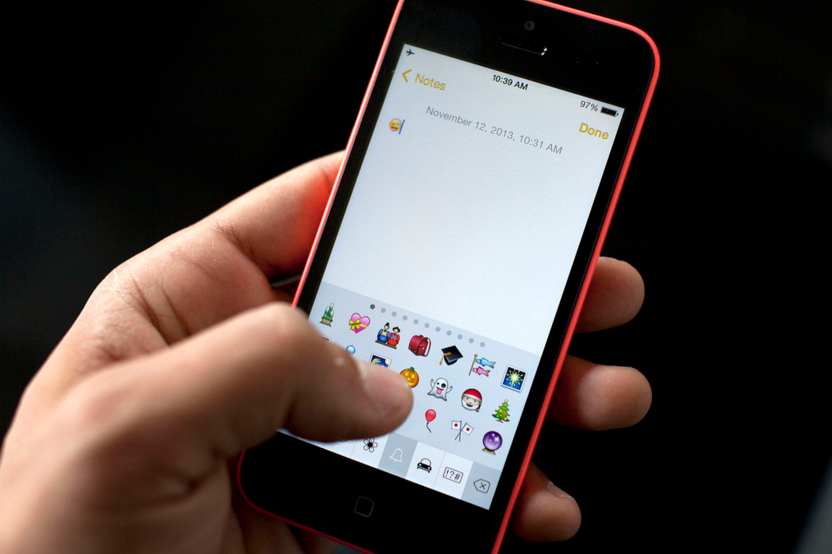Lifestyle
Emojimania: Fans and brands crying tears of joy

(Photo from Flickr/downloadsource.fr)
NEW YORK – When it comes to emojis, the future is very, very… Face with Tears of Joy.
If you don’t know what that means then you: a) aren’t a 14-year-old girl. b) love to hate those tiny pictures that people text you all the time. Or c) are nowhere near a smartphone or online chat.
Otherwise, here in 2016, it’s all emojis, all the time. And Face with Tears of Joy, by the way, is a bright yellow happy face with a classic, toothy grin as tears fall.
The Face was chosen by Oxford Dictionaries as its 2015 “word” of the year, based on its popularity and reflecting the rise of emojis to help charitable causes, promote businesses and generally assist oh-so-many-more of us in further expressing ourselves on social media and in texts.
The Beyhive knows. The collective fan base of Beyonce recently spammed Amber Rose with little bumblebee emojis when they sensed a diss of their queen.
Taco Bell also knows. Emoji overseers approved a taco character last year after a yearlong campaign by the company to get one up and running, rewarding users of said taco on Twitter with gifts of free photos, GIFs and other virtual playthings to celebrate.
So what’s it all about? Here’s a look at the past, present and rosy future of emojis:
Where did they come from?
While there’s now a strict definition of emojis as images created through standardized computer coding that works across platforms, they have many, many popular cousins by way of “stickers,” which are images without the wonky back end. Kimojis, the invention of Kim Kardashian, aren’t technically emojis, for instance, at least in the eyes of purists.
In tech lore, the great emoji explosion has a grandfather in Japan and his name is Shigetaka Kurita. He was inspired in the 1990s by manja and kanji when he and others on a team working to develop what is considered the world’s first widespread mobile Internet platform came up with some rudimentary characters. They were working a good decade before Apple developed a set of emojis for the first iPhones.
Emojis are either loads of fun or the bane of your existence. One thing is sure: There’s no worry they’ll become a “language” in and of themselves. While everybody from Coca-Cola to the Kitten Bowl have come up with little pictographs to whip up interest in themselves, emojis exist mainly to nuance the words regular folk type, standing in for tone of voice, facial expressions and physical gestures – extended middle finger emoji added recently.
“Words aren’t dead. Long live the emoji, long live the word,” laughed Gretchen McCulloch, a Toronto linguist who, like some others in her field, is studying emojis and other aspects of Internet language.
Emojis have been compared to hieroglyphs, but McCulloch is not on board. That ancient picture-speak included symbols with literal meaning, but others stood in for actual sound.
Emoji enthusiasts have played with telling word-free stories using their little darlings alone and translating song lyrics into the pictures, “but they can’t be put together like letters to make a pronounceable word,” McCulloch said.
The emoji overseers
Back when Kurita was creating some of the first emojis, chaos already had ensued in trying to make all the pagers and all the emerging mobile phones and the newfangled thing called email and everything else Internet-ish that was bubbling up speak to each other. And also to allow people in Japan used to a more formal way of communicating make themselves understood in the emerging shorthand.
Enter the Unicode Consortium, on the coding end. It’s a volunteer non-profit industry organization working in collaboration with the International Organization for Standardization, the latter an independent non-governmental body that helps develop specifications for all sorts of things, including emojis, on a global scale.
Unicode, co-founded and headed by Mark Davis in Zurich, has a big, big mission, of which emojis have a place: making sure all the languages in the world are encoded and supported across platforms and devices.
The key word here is volunteer. Davis has a whole other job at Google, but he has dedicated himself to the task above. He also co-chairs the consortium’s emoji subcommittee, a cog in a vetting process for new emojis that can take up to two years before new ones are put into the Unicode Standard for the likes of Apple, Google, Microsoft and Facebook to do with what they wish.
Where does Davis sit with the rapid rise of emojis?
“It has been a surprise. We didn’t fully understand how popular they were going to be,” he said.
At the moment, Unicode has released 1,624 emojis, with more options when you factor in modifiers for such things as skin tone. The emoji subcommittee fields about 100 proposals for new emojis a year. Not all make it through the vetting process.
“We don’t encode emoji for movie or fictional people, or for deities. And we’re not going to give you a Donald Trump,” Davis said.
Gender, he said, is among the next frontiers for emojis. Demand for a female runner, for instance, will be voted on in May as critics have questioned a male-female divide. The consortium is trying to come up with a way to more easily and quickly customize emoji for gender, hair colour and other features, Davis said.
“Personally, I am very much looking forward to a face palm emoji,” he joked.
Emoji lovers and haters
Meet Elle Brown. She’s a 9-year-old “kidpreneur” from Plant City, Florida. She makes emoji-theme jewelry and key fobs that she sells at school and church, and that her mom sells from her desk at an insurance firm.
“My favourite one is the ‘poo’ emoji, and the money emoji,” said Elle.
People of all ages buy from her mom, Zee Brown.
“It’s like having Girl Scout cookies. People come to me,” she said.
While marketers are all over emojis these days, professional brander Kevin Winslow in Boise, Idaho, was a reluctant adopter.
“I thought they were rather silly. It didn’t seem to me like something a grown-up would use,” he said. “Now they’re a necessity in social media campaigns. Sometimes they help do away with the exclamation point, which I also despise.”
Vivian Rosenthal is founder and head of Snaps, a platform on which keyboards full of branded images are launched, including marketing campaigns intended to support social causes, such as the plight of refugees.
With nearly half of all Instagram posts now including at least one emoji and with more than 270 billion text messages sent a day across all mobile devices, brands are trying big time to monetize emojis, Rosenthal said.
“Basically, messaging is social 2.0,” she added. “People want to convey more and more emotion. The language of the future is a visually based language. It’s very universal and democratic.”
Rosenthal estimated somewhere around 6 billion emojis and stickers are sent every day across devices and services.
Emojis and the youngins
Clearly, emojis are the darlings of the Millennial and GenZ generations. Other age groups are in the game, but Tayfun Karadeniz said age isn’t the entire story.
He’s the founder and head of EmojiXpress, a third-party app for iOS that supplies users with every emoji available in the Unicode Standard. He’s also a new voting member of the Unicode Consortium.
Of roughly 50 million downloads of his app over the last three years, 80 per cent of his users are female. Are they just about the fun? Are we, in the grand scheme, now dependent on emojis in some profound way?
“I wouldn’t say our society would break down if we didn’t have them, but you could also ask why do we need art, why do we need TV shows?”
Akash Nigam, the 23-year-old co-founder and chief executive of Blend, a group messaging app focused on Millennials and GenZers, thinks emoji use among those age groups has a slightly more urgent element.
“They’re integral to their daily lives,” he said. “With this audience, it’s kind of like the punch line. Whoever uses the most unique emojis alongside a very witty text kind of gets the most kudos. Everybody is always pounding their keyboards looking for emojis that haven’t been used. I mean, yeah, you could paint a picture or write an essay, but it doesn’t feel the same.”





















